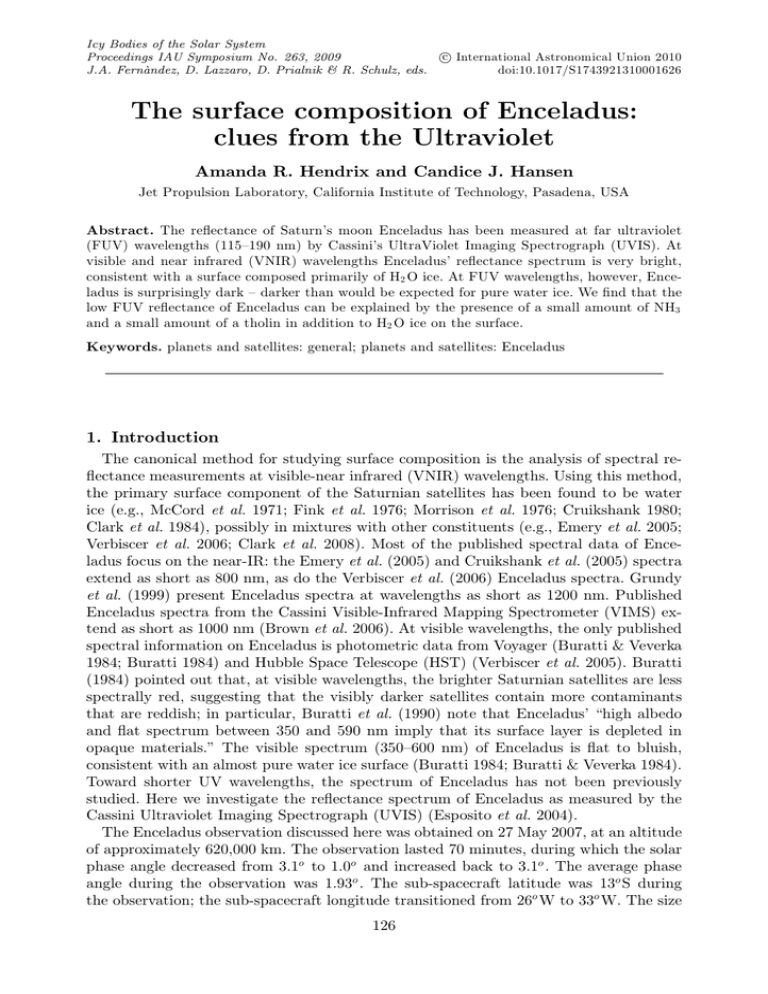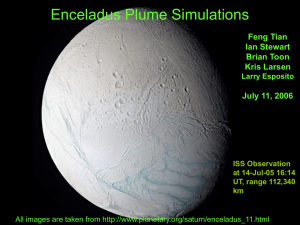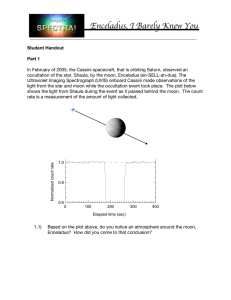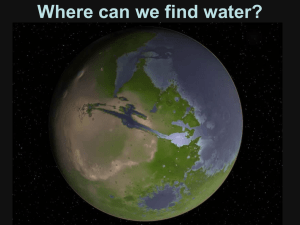Document 12631223
advertisement

Icy Bodies of the Solar System c International Astronomical Union 2010 Proceedings IAU Symposium No. 263, 2009 J.A. Fernàndez, D. Lazzaro, D. Prialnik & R. Schulz, eds. doi:10.1017/S1743921310001626 The surface composition of Enceladus: clues from the Ultraviolet Amanda R. Hendrix and Candice J. Hansen Jet Propulsion Laboratory, California Institute of Technology, Pasadena, USA Abstract. The reflectance of Saturn’s moon Enceladus has been measured at far ultraviolet (FUV) wavelengths (115–190 nm) by Cassini’s UltraViolet Imaging Spectrograph (UVIS). At visible and near infrared (VNIR) wavelengths Enceladus’ reflectance spectrum is very bright, consistent with a surface composed primarily of H2 O ice. At FUV wavelengths, however, Enceladus is surprisingly dark – darker than would be expected for pure water ice. We find that the low FUV reflectance of Enceladus can be explained by the presence of a small amount of NH3 and a small amount of a tholin in addition to H2 O ice on the surface. Keywords. planets and satellites: general; planets and satellites: Enceladus 1. Introduction The canonical method for studying surface composition is the analysis of spectral reflectance measurements at visible-near infrared (VNIR) wavelengths. Using this method, the primary surface component of the Saturnian satellites has been found to be water ice (e.g., McCord et al. 1971; Fink et al. 1976; Morrison et al. 1976; Cruikshank 1980; Clark et al. 1984), possibly in mixtures with other constituents (e.g., Emery et al. 2005; Verbiscer et al. 2006; Clark et al. 2008). Most of the published spectral data of Enceladus focus on the near-IR: the Emery et al. (2005) and Cruikshank et al. (2005) spectra extend as short as 800 nm, as do the Verbiscer et al. (2006) Enceladus spectra. Grundy et al. (1999) present Enceladus spectra at wavelengths as short as 1200 nm. Published Enceladus spectra from the Cassini Visible-Infrared Mapping Spectrometer (VIMS) extend as short as 1000 nm (Brown et al. 2006). At visible wavelengths, the only published spectral information on Enceladus is photometric data from Voyager (Buratti & Veverka 1984; Buratti 1984) and Hubble Space Telescope (HST) (Verbiscer et al. 2005). Buratti (1984) pointed out that, at visible wavelengths, the brighter Saturnian satellites are less spectrally red, suggesting that the visibly darker satellites contain more contaminants that are reddish; in particular, Buratti et al. (1990) note that Enceladus’ “high albedo and flat spectrum between 350 and 590 nm imply that its surface layer is depleted in opaque materials.” The visible spectrum (350–600 nm) of Enceladus is flat to bluish, consistent with an almost pure water ice surface (Buratti 1984; Buratti & Veverka 1984). Toward shorter UV wavelengths, the spectrum of Enceladus has not been previously studied. Here we investigate the reflectance spectrum of Enceladus as measured by the Cassini Ultraviolet Imaging Spectrograph (UVIS) (Esposito et al. 2004). The Enceladus observation discussed here was obtained on 27 May 2007, at an altitude of approximately 620,000 km. The observation lasted 70 minutes, during which the solar phase angle decreased from 3.1o to 1.0o and increased back to 3.1o . The average phase angle during the observation was 1.93o . The sub-spacecraft latitude was 13o S during the observation; the sub-spacecraft longitude transitioned from 26o W to 33o W. The size 126 The surface composition of Enceladus 127 of the Enceladus disk during this observation was 0.8 mrad; the size of a UVIS pixel during this observation was 1.0 × 1.5 mrad, so Enceladus was sub-pixel in size and UVIS measured a disk-average spectrum. We calculate the disk-average reflectance by taking into account the size of the body in the UVIS slit and dividing by the solar spectrum as measured by SORCE SOLSTICE (McClintock et al. 2000), scaled to 9.2 AU, Enceladus’ heliocentric distance on the day of the observation. We use the Hapke (2002) model to represent the reflectance spectra of individual species given their optical constants, and we use spectral mixing models with varying amounts of different species to try to replicate the spectral magnitude and shape observed at Enceladus, following the methods outlined by Hendrix & Hansen (2008). Laboratory measurements of water ice in the ultraviolet have had varying results. Several measurements of the optical constants n and k have been made: Warren (1984) provides a compilation of the measurements of hexagonal ice in the 44–2270 nm wavelength range and Warren & Brandt (2008) recently updated the compilation. Absorption by ice in the near- and mid-UV (∼ 200–400 nm) is very weak (Warren & Brandt 2008) but the location of minimum absorption is unclear. There is a lack of optical constant information in the ultraviolet, and as a result, the Warren (1984) and Warren & Brandt (2008) compilations include an interpolation between 161 nm and 180 nm, the Warren (1984) compilation also interpolates between 185 nm and 400 nm (Fig. 3), and the Warren & Brandt (2008) compilation extrapolates between 180 and 200 nm. The Warren & Brandt (2008) compilation uses a different data set in the 390–600 nm range than the Warren (1984) compilation, and leaves a gap in the 200–390 nm range. The Warren & Brandt (2008) data focus mainly on temperatures applicable at Earth; thus, these data are not appropriate for Enceladus-like (e.g., 80 K) temperatures. Nevertheless, we use the Warren & Brandt (2008)) optical constants for water ice in our models, as no other data are currently available. (As pointed out by Warren (1984), Shibaguchi et al. (1977) measured only small variations in optical density with temperature (83 K–160 K) in the 120–150 nm region; any temperature dependence in the optical constants of water ice at λ > 150 nm is unknown.) 2. The far-UV spectrum of Enceladus does not agree with pure H2 O ice In Fig. 1a is shown the far-UV (FUV) reflectance spectrum of Enceladus. The UVIS spectrum is dark at wavelengths < 165 nm; the onset in brightness due to water ice is detected at 165 nm; at wavelengths ∼170–∼185 nm, the spectrum is relatively flat, producing a “ledge” in the overall spectrum; the spectrum appears to begin increasing again (possibly the shoulder of an absorption edge) at ∼185 nm. We combine the FUV spectrum with published VNIR data to create a composite spectrum (Fig. 1b). Clearly, Enceladus exhibits a strong, abrupt decrease in reflectance in the middle-UV (MUV) region, as suggested by the single MUV data point of Verbiscer et al. (2006), and because the FUV spectrum is much darker than the visible spectrum. Water ice exhibits a strong dropoff in reflectance in the UV - but the H2 O absorption edge occurs in the FUV (at ∼165 nm, depending on grain size as shown in Fig. 1a), and is not responsible for the decrease in brightness of Enceladus at λ < 336 nm, nor for the darkness of the Enceladus spectrum at λ = 170–185 nm. Thus, pure water ice models (Fig. 1) are much too bright to fit the UVIS Enceladus spectrum. 128 A. R. Hendrix & C. J. Hansen Figure 1. Enceladus spectra compared with water ice spectral models. (left) UVIS Enceladus disk-average reflectance spectrum at solar phase = 2o . (right) Enceladus data from UVIS and Verbiscer et al. (2005) (plus signs), also at 2o solar phase angle. (red) areal mixture of 2 grain sizes; (blue) areal mixture of 2 intimate mixtures of 2 grain sizes. Both models are too bright to fit the UVIS data in the 160–190 nm range and do not exhibit the dropoff in brightness that evidently occurs in the near-UV (∼ 300 nm). 3. Spectral mixture models We have investigated candidate species that could be present at Enceladus and could meet the criteria of being bright and featureless in the visible, largely featureless in the near-IR, featureless in the 120–190 nm region, and having a UV absorption edge in the 190–280 nm, with perhaps a weaker absorption in the 280–400 nm region. We tried different mixtures of H2 O, CO2 , tholins and NH3 . Other candidate species are naturally possible, but published optical constant data in the far-UV are not available. The UV spectrum of carbon dioxide frost is not consistent with the Enceladus spectrum, so we do not consider CO2 to be important in our considerations. Understanding that including more than ∼2% of either a tholin or NH3 adversely affects the spectral fits in the visible (as well as in the near-IR), we constrained the amount of those species to 1% in intimate mixtures with H2 O ice. We find that mixture models with 1% each of ice tholin and NH3 result in spectra that are consistent with the Enceladus spectrum: they do not match exactly, but they reproduce the overall spectral features. We also find that if we model the NH3 –H2 O intimate mixture as being present on only a portion of the body (e.g., the south polar region), with pure water ice everywhere else on the surface, that we get poor fits to the Enceladus spectrum; areal mixtures with more than ∼20% pure H2 O ice are simply too bright to agree with the UVIS spectrum; suggesting a more global coverage Figure 2. Enceladus data (as in Fig. 1) compared with spectral intimate mixture models using H2 O ice, ice tholin and NH3 with varying grain sizes. The surface composition of Enceladus 129 by the intimate mixture, possibly due to E-ring grain interaction. Satisfactory fits are obtained when assuming global coverage of the NH3 –H2 O-tholin mixture. 4. Implications It is now known that Enceladus hosts water vapor jets with sources at the south polar hot spot (Hansen et al. 2006; Porco et al. 2006; Spencer et al. 2006; Dougherty et al. 2006). The plume gases include >90% H2 O (Hansen et al. 2006; Waite et al. 2006) in addition to small amounts of NH3 (0.8%) and other trace species (Waite et al. 2006; Waite et al. 2009), including several types of hydrocarbons. UVIS likely detects the plume NH3 that has been redeposited on the surface on Enceladus; however, it appears that the NH3 is not present only in the south polar region, but globally, suggesting a different transport process such as E-ring interactions. Though ammonia is not expected to be stable to photoloysis and radiolysis at the surface of Enceladus, ammonia hydrate may be stable, and we cannot rule out that it is not pure ammonia but ammonia hydrate (or a related species) that causes the strong UV dropoff. The presence of vaporous NH3 in the Enceladus plume (Waite et al. 2009) suggests that the NH3 could condense along with H2 O in the E-ring), which would replenish NH3 on the surface of Enceladus via E-ring grain coating (Buratti 1988; Buratti et al. 1990), even in regions away from the south polar region. Redeposited plume material, along with coating by E-ring grains, contributes to the brightness of Enceladus’ surface. Verbiscer et al. (2007) suggest that Enceladus is so bright because of this recoating, an idea first suggested by Buratti (1988) and supported by Hamilton & Burns (1994). Acknowledgements This research was carried out at the Jet Propulsion Laboratory, California Institute of Technology, under a contract with the National Aeronautics and Space Administration. References Brown, R. H. et al. 2006, Science, 311, 1425 Buratti, B. 1984, Icarus, 59, 392 Buratti, B. J., Mosher, J. A., & Johnson, T. V. 1990, Icarus, 87, 339 Buratti, B. J. & Veverka, J. 1984, Icarus, 58, 254 Clark, R. N., Brown, R. H., Owensby, P. D., & Steele, A. 1984, Icarus, 58, 265 Clark, R. N., Curchin, J. M., Jaumann, R., Cruikshank, D. P., Brown, R. H., Hoefen, T. M., Stephan, K., Moore, J. M., Buratti, B. J., Baines, K. H., Nicholson, P. D., & Nelson, R. M. 2008, Icarus, 193, 372 Cruikshank, D. P. 1980, Icarus, 41, 246 Cruikshank, D. P., Owen, T. C., Dalle Ore, C., Geballe, T. R., Roush, T. L., de Bergh, C. Sandford, S. A., Poulet, F., Benedix, G. K., & Emery, J. P. 2005, Icarus, 175, 268 Dougherty, M. K., Khurana, K. K., Neubauer, F. M., Russell, C. T., Saur, J., Leisner, J. S., & Burton, M. E. 2006, Science, 311, 1406 Emery, J. P., Burr, D. M., Cruikshank, D. P., Brown, R. H., & Dalton, J. B. 2005, A&A, 435, 353 Esposito, L. W. et al. 2004. Space Sci. Rev., 115, 299 Fink, U., Larson, H. P., Gautier III., T. N., & Treffers, R. R. 1976, ApJ, 207, L63 Grundy, W. M., Buie, M. W., Stansberry, J. A., & Spencer, J. R. 1999, Icarus, 142, 536 Hamilton, D. P. & Burns, J. A. 1994, Science, 264, 550 130 A. R. Hendrix & C. J. Hansen Hansen, C. J., Esposito, L., Stewart, A. I. F., Colwell, J., Hendrix, A., Pryor, W., Shemansky, D., & West, R. 2006, Science, 311, 1422 Hapke, B. W. 2002, Icarus 157, 523 Hendrix, A. R. & Hansen, C. J. 2008, Icarus, 193, 323 McClintock, W. E., Rottman, G. J., & Woods, T. N. 2000, Earth Observing System V, Proceedings of the SPIE, 4135, 225 McCord, T. B., Johnson, T. V., & Elias, J. H. 1971, ApJ, 165, 413 Morrison, D., Cruikshank, D. P., Pilcher, C. B., & Rieke, G. H. 1976, ApJ, 207, L213 Porco, C. C. et al. 2006, Science, 311, 1393 Shibaguchi, T., Onuki, H., & Onaka, R. 1977, J. Phys. Soc. Jpn., 42, 152 Spencer, J. R., Pearl, J. C., Segura, M., Flasar, F. M., Mamoutkine, A., Romani, P., Buratti, B. J., Hendrix, A. R., Spilker, L. J., & Lopes, R. M. C. 2006, Science, 311, 1401 Verbiscer, A. J., French, R. G., & McGhee, C. A. 2005, Icarus, 173, 66 Verbiscer, A. J., Peterson, D. E., Skrutskie, M. F., Cushing, M., Helfenstein, P., Nelson, M. J., Smith, J. D., & Wilson, J. C. 2006, Icarus, 182, 211 Verbiscer, A., French, R., Showalter, M., & Helfenstein, P. 2007, Science, 315, 815 Waite, J. H., Combi, M. R., Ip, W.-H., Cravens, T. E., McNutt Jr., R. L., Kasprzak, W., Yelle, R., Luhmann, J., Niemann, H., Gell, D., Magee, B., Fletcher, G., Lunine, J., & Tseng W.-L. 2006, Science, 311, 1419 Waite, Jr., J. H., Lewis, W. S., Magee, B. A., Lunine, J. I., McKinnon, W. B., Glein, C. R., Mousis, O., Young, D. T., Brockwell, T., Westlake, J., Nguyen, M.-J., Teolis, B. D., Niemann, H. B., McNutt Jr., R. L., Perry, M., & Ip, W.-H. 2009, Nature, 460, 487 Warren, S. G. 1984, Appl. Optics, 23, 1206 Warren, S. G. & Brandt, R. E. 2008, J. Geophys. Res., 113, D14220, doi: 10.1029/2007JD009744




